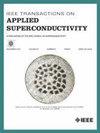Short Circuit Analysis of a Fully Superconducting 10 MW Wind Generator
IF 1.7
3区 物理与天体物理
Q3 ENGINEERING, ELECTRICAL & ELECTRONIC
引用次数: 0
Abstract
Transient short circuit simulations of conventional machines are well known and offer the possibility of predicting the short circuit behavior of a machine with a high degree of accuracy. Although the ohmic resistance in the superconducting state is negligible, the non-linearity during quenching is difficult to integrate into a model. In order to predict the thermal or mechanical destruction of the superconductor, calculation models are required that take into account the classic machine models and the physical behavior of the superconductor. This paper presents an extended calculation model with a transient finite element (FE) simulation for a fully superconducting wind generator. The model considers the critical current of a superconductor with the influence of the layer structure of the High Temperature Superconducting (HTS) tape. In addition, an analytical calculation model is presented, which is compared with the FE model.求助全文
约1分钟内获得全文
求助全文
来源期刊

IEEE Transactions on Applied Superconductivity
工程技术-工程:电子与电气
CiteScore
3.50
自引率
33.30%
发文量
650
审稿时长
2.3 months
期刊介绍:
IEEE Transactions on Applied Superconductivity (TAS) contains articles on the applications of superconductivity and other relevant technology. Electronic applications include analog and digital circuits employing thin films and active devices such as Josephson junctions. Large scale applications include magnets for power applications such as motors and generators, for magnetic resonance, for accelerators, and cable applications such as power transmission.
 求助内容:
求助内容: 应助结果提醒方式:
应助结果提醒方式:


